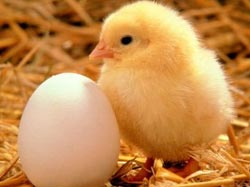Life before protein
Early cells may have energized through molecular membranes with fat. Long before the chickens and eggs, life had to solve the difficult problem of 'chicken first or eggs first'.
The first cells on the early earth needed nutrients from the surrounding environment to grow and reproduce long enough to evolve complex proteins. But the membrane that encapsulates modern cells needs complex proteins that act as absorbent holes for nutrition to enter the cell. The hypothesis is that early cells do not need these complex protein holes, so scientists wonder how the first living cells derive nutrients from the external environment.
While trying to create simple artificial cells like the original, the researchers found a possible way for this situation. By creating artificial membranes from different fat molecular compounds from the membrane of modern cells, scientists discovered the formula that membranes allow nutrients to enter the cell.
Previous experiments demonstrated that the fat molecule used in experiments may have existed on Earth before life began, and in saline these molecules spontaneously curled into small spheres and then from That makes up the first cell.
It is suspected that the first living cells actually have membranes from the correct compounds used in those experiments, scientists agree. But the work shows that this may be a natural rule that early cells receive nutrients from the environment without the help of proteins. The group presented on the online Nature edition June 4.

Previous chicken or egg first?(Photo: www.cooltownstudios.com )
According to lead scientist Jack Szostak, a geneticist at Massachusetts General Hospital in Boston, 'I don't think there's any previous work that demonstrates that you can get nutrients through the membrane. This is the first close-up look at how it works. '
While membranes, consisting of fatty acids and glycerol monoester instead of phospholipids found in today's cells, allow small nutrients to pass through, molecules similar to larger DNA are trapped inside the sphere. So cells made from this membrane can retain their genetic code.
The work 'will definitely have a certain contribution when it comes to thinking that the enclosures surrounded by simple films can exist naturally', according to Robert Shapiro, a researcher of life origin at New University. York.
Szotak's ultimate goal is to create a simple life form of artificial life by wrapping DNA-like molecules, multiplying within such membranes and providing nutrition to the 'pre-cells'. can grow and divide.
'If we don't try to make cells, we will never discover this.'
- Animal protein is very harmful to health
- 10 great plant protein sources to replace animal protein
- Protein discovery decides to conceive successfully
- Country: Things you don't know
- What is the role of protein to health?
- Protein has the ability to burn body fat
- What do you know about 'vegetarian' meat?
- High-protein diets help people reduce their risk of stroke
- Diet helps to maintain the 'spring age' of the brain
- Reducing the consumption of animal protein will help prolong life
- Find a protein that makes women difficult to give birth
- What is protein thermal shock? Can proteins help us fight cancer?
 Why do potatoes have eyes?
Why do potatoes have eyes? 'Tragedy' the world's largest carnivorous life: Death becomes ... public toilet
'Tragedy' the world's largest carnivorous life: Death becomes ... public toilet Tomatoes were once considered 'poisonous' for 200 years
Tomatoes were once considered 'poisonous' for 200 years Detecting microscopic parasites on human face
Detecting microscopic parasites on human face